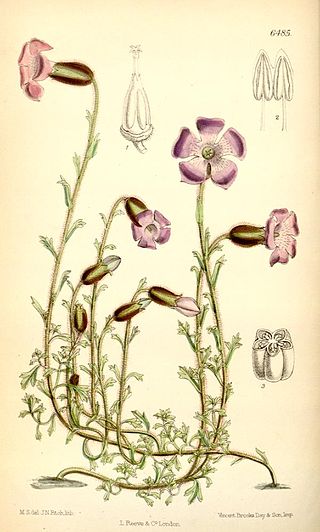
Adonis is a genus of about 20–30 species of flowering plants of the crowfoot family, Ranunculaceae, native to Europe and Asia.

Cyananthus lobatus, commonly known as the lobed-leaved cyananth or trailing bellflower, is an ornamental flowering plant of the family Campanulaceae.

Calochortus albus is a North American species in the genus Calochortus in the family Liliaceae. It is also known by the common names fairy lantern, white fairy lantern, pink fairy lantern, lantern of the fairies, globe lily, white globe lily, white globe-tulip, alabaster tulip, Indian bells,satin bells, snowy lily-bell, and snow drops.

Deutzia gracilis, the slender deutzia or Japanese snow flower, is a species of flowering plant in the hydrangea family Hydrangeaceae, native to Japan.

Brunfelsia latifolia, commonly known as yesterday-today-tomorrow and kiss me quick, is a species of flowering plant in the nightshade family. Endemic to Brazil, it is an evergreen shrub that becomes semi-deciduous in cooler areas and grows up to 1.8 meters in height.

Hedera nepalensis is a species of perennial Ivy native to Nepal and Bhutan, as well as Afghanistan, Pakistan, India, China, Laos, Myanmar, Thailand, and Vietnam, at altitudes of about 1000–3000 m. Plants grow up to 30 m in height, with simple leaves ranging from 2–15 cm long, and yellow flowers.
Minuartia bosniaca, or Bosnian sandwort, in Bosnian bosanska mišjakinjica, is endemic plant at East Dinaric mountains. Itbelongs to family of Caryophyllaceae (carnations).
Hypericum cuisinii is a perennial herb in the genus Hypericum, in the section Adenosepalum. The herb has pale yellow flowers and occurs in Greece and Turkey.

Passiflora bogotensis is a climbing plant native to Colombia, in the genus Passiflora. It can also be found in Venezuela.

Prunus himalayana, called jyokun shin in Tibetan and 喜马拉雅臭樱 in Chinese, is a species of Prunus native to Nepal, Bhutan, Sikkim and Tibet. It prefers to grow 2,800 to 4,200 m above sea level in the Himalayas. As Maddenia himalaica it was the type species for the now unrecognized genus Maddenia.
Colona thorelii is a species small tree, in the family Malvaceae and now placed in the subfamily Grewioideae; it is named after the French botanist Clovis Thorel. No subspecies are listed in the Catalogue of Life.
Salix balfouriana is a shrub or small tree from the genus of willow (Salix) with reddish black and tomentose hairy young twigs and up to 8 leaf blades, rarely 18 centimeters long. The natural range of the species is in China.

Salix cheilophila is a shrub or small tree from the genus of willow (Salix) with initially tomentose hairy and later balding branches. The leaf blades have lengths of 2.5 to sometimes 6 centimeters. The natural range of the species is in China.
Hoffmannanthus is a monotypic genus of flowering plants in the Asteraceae. There is only one known species, Hoffmannanthus abbotianus(O.Hoffm.) H.Rob., S.C.Keeley & Skvarla Its native range is Uganda and southern Tropical Africa. It is found in the countries of Angola, Kenya, Tanzania, Uganda, Zambia and Zaïre.
Zanthoxylum dissitum is a woody plant native to China. It grows in upland thickets and open forests, forests, at 300-2600 m altitude.
Zanthoxylum esquirolii is a woody plant in the family Rutaceae from Guizhou, Sichuan, and Yunnan China.
Zanthoxylum micranthum is a woody plant in the family Rutaceae. It is native to Hubei, Hunan, Guizhou, Sichuan, and Yunnan provinces in China.
Zanthoxylum yuanjiangensis is a woody plant in the Rutaceae. It is native to Yuanjiang, Yunnan, China.
Rubus swinhoei is also known as Swinhoe's raspberry, wood berry, Keelung rubus, Jingbai rubus and Libai rubus. It belongs to the genus Rubus of the family Rosaceae and is named after Robert Swinhoe for his contributions to Taiwan’s fauna and flora.

Echium salmanticum is a species of plant belonging to the family Boraginaceae.




















